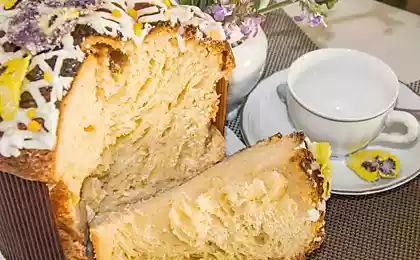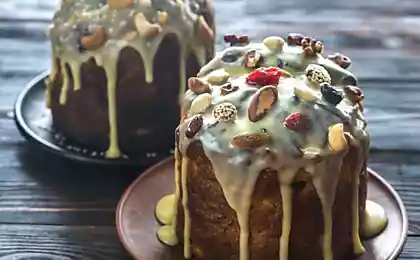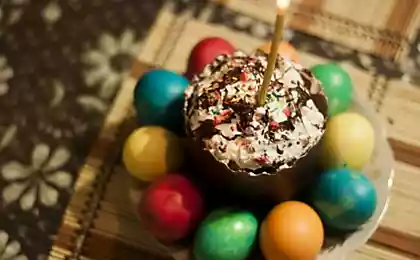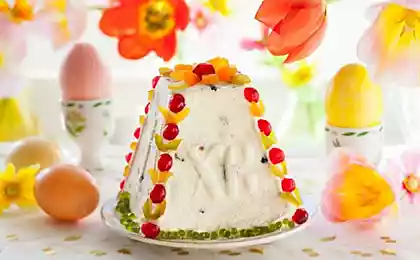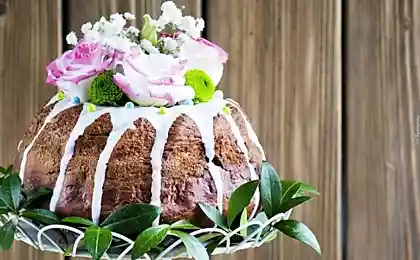656
Easter cake — a story of misconceptions
The approaching Easter holiday is invariably associated with cakes. High, sweet drizzled on top of sweet fondant. These are the cakes and are today to consecrate the Church on Holy Saturday. But the question is: whether they have always been like this?
Think about it, it would be possible, even on the basis of simple considerations. Today's lace muffin – not so ancient an expedition to new culinary practices. It is clear that several centuries ago the Russian pastries such could not be. Yes, the cake was always a festive product made from wheat flour (expensive and not very available). But, most likely, he resembled his "close relative" — Kalach.
By the way, this tune – possibly by accident. After all, the word "loaf" is derived from the Slavic "Kolo" (circle, wheel, ring). The letter "a" appeared in the fall of the reduced vowels and consolidation "Akane" on the letter. A "cake" comes from the Greek κουλλίκι(ον) and κόλλιξ, which means "bread round or oval shape." That, however, does not negate the hypothesis that both these names are descended from the more ancient word meaning "round".
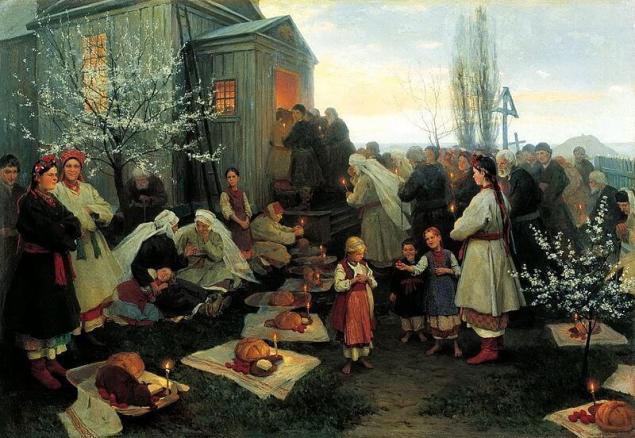
But what was that old cake? Because, you see, it is difficult to assume that in the peasant's hut, even in the early nineteenth century had special molds (clay, copper?) for baking of this product. They, of course, was not. But to restore the look of the cake it is possible. Let's try to unravel this culinary mystery.
Help us in this and cook books, old dictionaries, and paintings of Russian artists.
The lack of domestic cookbooks until the late eighteenth century does not allow to understand the intricacies of the recipe. However, it is evident that 200 years ago cake in Russia was baked without form. He was a hearth, i.e., prepared to either "the hearth" in the oven or on the baking sheet. This type of cake is preserved for a long time. In fact, in the first half of the XX century in the villages it is often so baked.
And in the nineteenth century hearth cake even mentioned in the most famous cookbooks. Here, for example, "St. Petersburg cuisine" Ignatius Radetzky (1862). Please note – "roll out the dough... put on otsloeny oil ceiling":

The word "ceiling" is somewhat alarming. Maybe that is today's mold for cake? However, do not. According to the Historical dictionary of Russian gallicisms (Wiley, 2010), "ceiling" is "obsolete., cooking.. A large metal plate for cooking in the oven". There is also a link to "Almanac of groceries" Radetzky: "Below shelves around the walls <kitchen> tables with footrests, footrests are placed on the ceiling, trays, sheets and the like" (Radetsky 1852 1 p. IX).
Hearth cakes were not only in books. Their images we find in the paintings of those years. Noticed on the top picture? It's written in 1891 painting by Nikolai Pimonenko "the Easter Matins in the Ukraine". Now take a closer look to part of it:
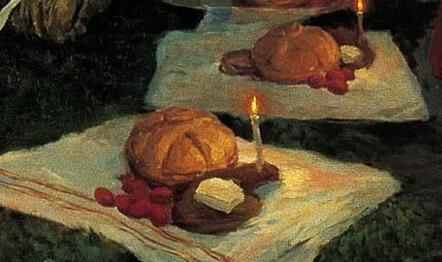
Isn't it, not like today's cakes? Someone will say: "Well, it's "little Russia", in Russia it was not so." And make a mistake. Since it's written already in Russian reality painting by Vladimir Makovsky "Prayer at Easter" (1887) only confirms the General rule.
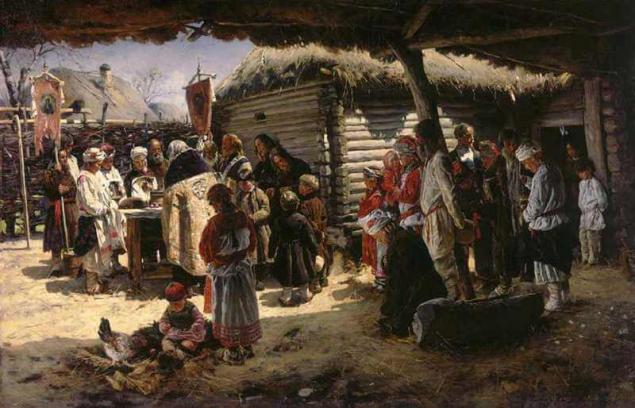
Pay attention to the fragment of this painting. Eggs and fruit cake:
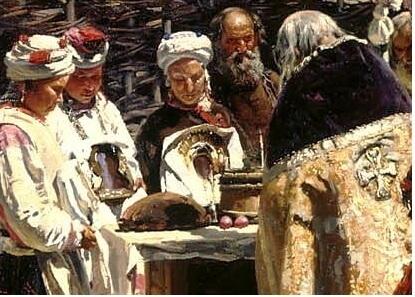
Or another example:
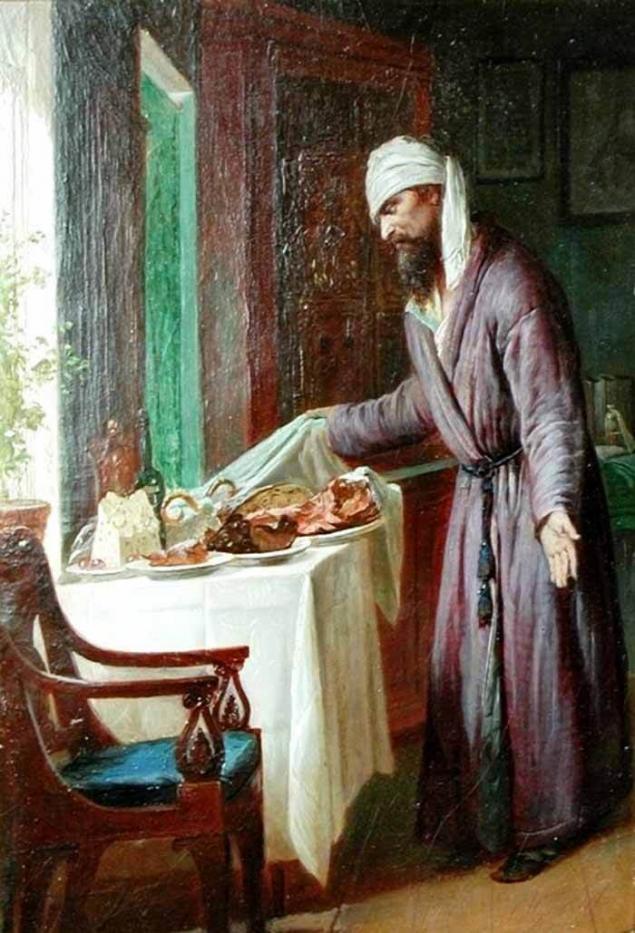
Zhuravlev, F. S. Easter feast (up to 1901)
Look more the fragment. Under the napkin is clearly a piece of cake (and what bread baking can be for Easter?). And this cake baked.
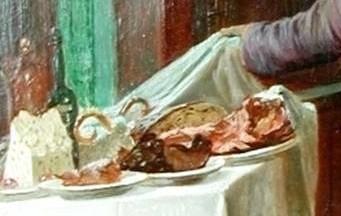
And here's the Easter card early XX century. What is on the table next to the colored eggs? Right – hearth cake:

This tradition is not dead we and later. When, it would seem, with forms for cakes are no problem was not.
Here before you is a picture of the artist Ivan Vladimirov (1869-1947). It's not a loaf of bread surrounded by Easter eggs?
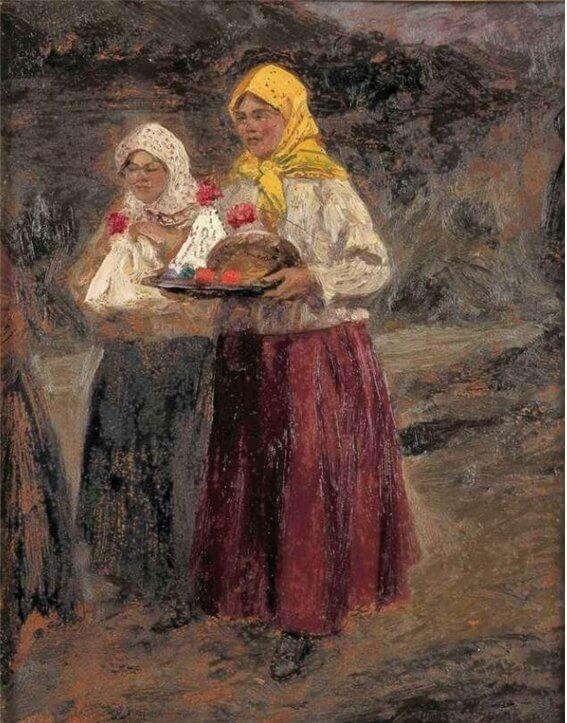
Vladimirov I. Matins
Unlike today's Easter cake dough in the hearth was more dense, but not "lace". And if Radetzky describes it in an elegant kitchen, then, say, P. Andreev brings his recipe in his book "Cheap Russian table" (St. Petersburg, 1898), talking about very "democratic" menu poor public:
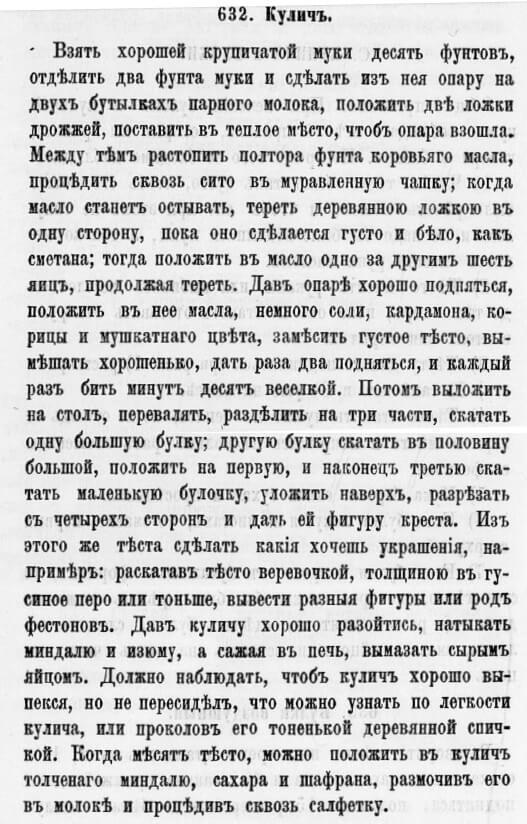
But when the cake was given its current form? The answer to this question will be difficult. Because the process was long in our kitchen. First try to figure out what pastries reminds us of today's high holiday cake? That's right – the woman, the grandmother (it is often called and rum Baba). This in Soviet times, the rum Baba was a little sweet bun with raisins that fit in the palm of your hand. But in classic view it is comparable to cake on the product.
And his biography it leads from the eighteenth century. It is believed that the cook of the deposed Polish king Stanislaw Leszczynski Nicolas Stohrer in 1720-ies were brought to France the recipe for "Baba". A connoisseur of good food, Leszczynski dipped once Alsatian kouglof (dry seemed to him) into wine. The result impressed him. And a new dessert was named after a favorite hero of king Ali Baba.
Version with this title, though described in the literature — not the fact that reliable. After all, the word "Baba" or "Babka" is also found in Russian and Ukrainian cuisine and Ali Baba has no relation. But over years check out this is impossible.
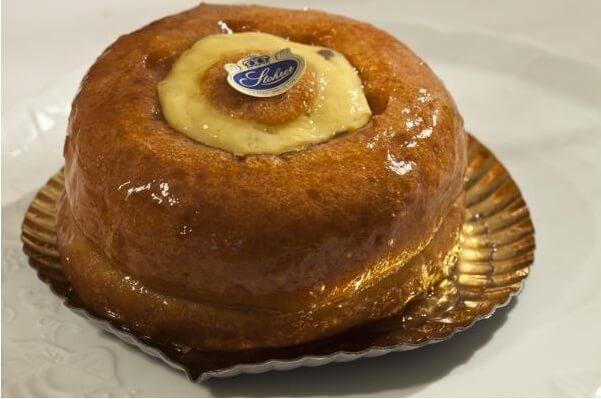
Today Baba from Pâtisserie Stohrer patisserie in Paris
(photo Helium Deleris)now, by order of the Royal Leszczynski chef Stohrer, perfected the recipe was used for preparation of Baba, the brioche dough with raisins. Such a woman-the brioche was baked with saffron, soaked with Malaga and was served with pastry cream, raisins and fresh grapes.
Famous deli French Brie-Savarin, after several decades have improved the dish. Under his skillful hands came known to us, "Baba" (Baba Au Rhum). He invented a special rum syrup, which was treated with Baba instead of wine, and called their treat "Baba Au Savarin". Dessert bought in France more popular, but the name stuck, which is known to us so far — Baba.
Pretty soon, with foreign cooks a rum Baba penetrates and Russia. For the first time about her can be read in the published in 1795, "the Dictionary povarennoi, pipesystem, konditerska and distillation". By the mid-nineteenth century – is already quite familiar dessert on the Russian table.
Although the memory of its origin were carefully preserved. Here, for example, published in 1862, "Petersburg kitchen" Ignatius Radetzky recipe is called "Baba king Stanislaw":
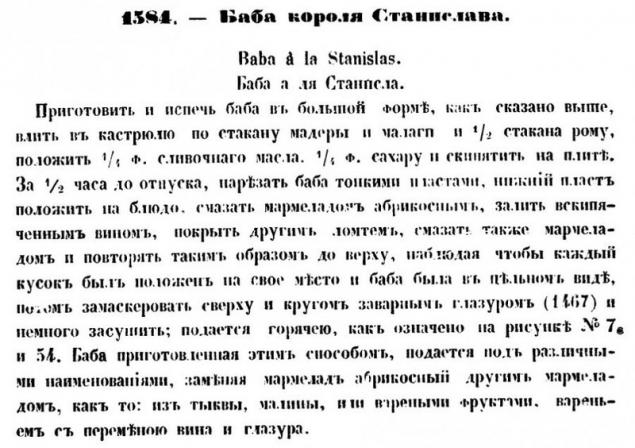
Having gained a foothold among the Russian public, this dish is beginning to expand its borders. And naturally came into conflict with the old cake. The logic of this process is clear. After all, people have always sought to make the cake more festive, rich, skoromniy. With this purpose there were added eggs, sugar, and dried fruit, used the choicest wheat flour. Achieved softness and muffins.
And then there is this "Baba". Here it is, it would seem that the ideal of the most elegant Easter cake, and even soaked in wine, rum.
So gradually, and there is a "replacement" one serves others, and often parallel existence. First, in affluent homes with elegant kitchen. And then already began to be sold these high shaped cakes.

Rum Baba (photos from the book Soviet confectioner Robert Kengis, 1981)Soviet way of life only cemented this process. It is clear that in the cities communal kitchens hearth oven cakes was difficult. In fact, one time all the word "cake" was in the Soviet Union is not entirely compatible with the "Soviet way of life".
Also interesting: the Perfect vanilla Easter with candied fruits and almonds from Julia Vysotskaya 35 minutes
Easter superstitions and beliefs of our people
Cupcake – it's a replacement for this ancient dish. Not having a religious connotation, the pastries conquered the local Housewives. Although, for some skill, quite reminiscent of a traditional cake. And produced by the Soviet bakeries cupcake "may" and all made up this evolution of the old dishes. He is, in fact, it is no coincidence that the so-called. As appeared in stores in the spring for Easter, and soon after it disappeared. This proletarian alternative was to defeat the Church cake. Failed. published
Author: Pavel Syutkin
P. S. And remember, only by changing their consumption — together we change the world! ©
Join us in Facebook , Vkontakte, Odnoklassniki
Source: p-syutkin.livejournal.com/277405.html
Think about it, it would be possible, even on the basis of simple considerations. Today's lace muffin – not so ancient an expedition to new culinary practices. It is clear that several centuries ago the Russian pastries such could not be. Yes, the cake was always a festive product made from wheat flour (expensive and not very available). But, most likely, he resembled his "close relative" — Kalach.
By the way, this tune – possibly by accident. After all, the word "loaf" is derived from the Slavic "Kolo" (circle, wheel, ring). The letter "a" appeared in the fall of the reduced vowels and consolidation "Akane" on the letter. A "cake" comes from the Greek κουλλίκι(ον) and κόλλιξ, which means "bread round or oval shape." That, however, does not negate the hypothesis that both these names are descended from the more ancient word meaning "round".

But what was that old cake? Because, you see, it is difficult to assume that in the peasant's hut, even in the early nineteenth century had special molds (clay, copper?) for baking of this product. They, of course, was not. But to restore the look of the cake it is possible. Let's try to unravel this culinary mystery.
Help us in this and cook books, old dictionaries, and paintings of Russian artists.
The lack of domestic cookbooks until the late eighteenth century does not allow to understand the intricacies of the recipe. However, it is evident that 200 years ago cake in Russia was baked without form. He was a hearth, i.e., prepared to either "the hearth" in the oven or on the baking sheet. This type of cake is preserved for a long time. In fact, in the first half of the XX century in the villages it is often so baked.
And in the nineteenth century hearth cake even mentioned in the most famous cookbooks. Here, for example, "St. Petersburg cuisine" Ignatius Radetzky (1862). Please note – "roll out the dough... put on otsloeny oil ceiling":

The word "ceiling" is somewhat alarming. Maybe that is today's mold for cake? However, do not. According to the Historical dictionary of Russian gallicisms (Wiley, 2010), "ceiling" is "obsolete., cooking.. A large metal plate for cooking in the oven". There is also a link to "Almanac of groceries" Radetzky: "Below shelves around the walls <kitchen> tables with footrests, footrests are placed on the ceiling, trays, sheets and the like" (Radetsky 1852 1 p. IX).
Hearth cakes were not only in books. Their images we find in the paintings of those years. Noticed on the top picture? It's written in 1891 painting by Nikolai Pimonenko "the Easter Matins in the Ukraine". Now take a closer look to part of it:

Isn't it, not like today's cakes? Someone will say: "Well, it's "little Russia", in Russia it was not so." And make a mistake. Since it's written already in Russian reality painting by Vladimir Makovsky "Prayer at Easter" (1887) only confirms the General rule.

Pay attention to the fragment of this painting. Eggs and fruit cake:

Or another example:

Zhuravlev, F. S. Easter feast (up to 1901)
Look more the fragment. Under the napkin is clearly a piece of cake (and what bread baking can be for Easter?). And this cake baked.

And here's the Easter card early XX century. What is on the table next to the colored eggs? Right – hearth cake:

This tradition is not dead we and later. When, it would seem, with forms for cakes are no problem was not.
Here before you is a picture of the artist Ivan Vladimirov (1869-1947). It's not a loaf of bread surrounded by Easter eggs?

Vladimirov I. Matins
Unlike today's Easter cake dough in the hearth was more dense, but not "lace". And if Radetzky describes it in an elegant kitchen, then, say, P. Andreev brings his recipe in his book "Cheap Russian table" (St. Petersburg, 1898), talking about very "democratic" menu poor public:

But when the cake was given its current form? The answer to this question will be difficult. Because the process was long in our kitchen. First try to figure out what pastries reminds us of today's high holiday cake? That's right – the woman, the grandmother (it is often called and rum Baba). This in Soviet times, the rum Baba was a little sweet bun with raisins that fit in the palm of your hand. But in classic view it is comparable to cake on the product.
And his biography it leads from the eighteenth century. It is believed that the cook of the deposed Polish king Stanislaw Leszczynski Nicolas Stohrer in 1720-ies were brought to France the recipe for "Baba". A connoisseur of good food, Leszczynski dipped once Alsatian kouglof (dry seemed to him) into wine. The result impressed him. And a new dessert was named after a favorite hero of king Ali Baba.
Version with this title, though described in the literature — not the fact that reliable. After all, the word "Baba" or "Babka" is also found in Russian and Ukrainian cuisine and Ali Baba has no relation. But over years check out this is impossible.

Today Baba from Pâtisserie Stohrer patisserie in Paris
(photo Helium Deleris)now, by order of the Royal Leszczynski chef Stohrer, perfected the recipe was used for preparation of Baba, the brioche dough with raisins. Such a woman-the brioche was baked with saffron, soaked with Malaga and was served with pastry cream, raisins and fresh grapes.
Famous deli French Brie-Savarin, after several decades have improved the dish. Under his skillful hands came known to us, "Baba" (Baba Au Rhum). He invented a special rum syrup, which was treated with Baba instead of wine, and called their treat "Baba Au Savarin". Dessert bought in France more popular, but the name stuck, which is known to us so far — Baba.
Pretty soon, with foreign cooks a rum Baba penetrates and Russia. For the first time about her can be read in the published in 1795, "the Dictionary povarennoi, pipesystem, konditerska and distillation". By the mid-nineteenth century – is already quite familiar dessert on the Russian table.
Although the memory of its origin were carefully preserved. Here, for example, published in 1862, "Petersburg kitchen" Ignatius Radetzky recipe is called "Baba king Stanislaw":

Having gained a foothold among the Russian public, this dish is beginning to expand its borders. And naturally came into conflict with the old cake. The logic of this process is clear. After all, people have always sought to make the cake more festive, rich, skoromniy. With this purpose there were added eggs, sugar, and dried fruit, used the choicest wheat flour. Achieved softness and muffins.
And then there is this "Baba". Here it is, it would seem that the ideal of the most elegant Easter cake, and even soaked in wine, rum.
So gradually, and there is a "replacement" one serves others, and often parallel existence. First, in affluent homes with elegant kitchen. And then already began to be sold these high shaped cakes.

Rum Baba (photos from the book Soviet confectioner Robert Kengis, 1981)Soviet way of life only cemented this process. It is clear that in the cities communal kitchens hearth oven cakes was difficult. In fact, one time all the word "cake" was in the Soviet Union is not entirely compatible with the "Soviet way of life".
Also interesting: the Perfect vanilla Easter with candied fruits and almonds from Julia Vysotskaya 35 minutes
Easter superstitions and beliefs of our people
Cupcake – it's a replacement for this ancient dish. Not having a religious connotation, the pastries conquered the local Housewives. Although, for some skill, quite reminiscent of a traditional cake. And produced by the Soviet bakeries cupcake "may" and all made up this evolution of the old dishes. He is, in fact, it is no coincidence that the so-called. As appeared in stores in the spring for Easter, and soon after it disappeared. This proletarian alternative was to defeat the Church cake. Failed. published
Author: Pavel Syutkin
P. S. And remember, only by changing their consumption — together we change the world! ©
Join us in Facebook , Vkontakte, Odnoklassniki
Source: p-syutkin.livejournal.com/277405.html


